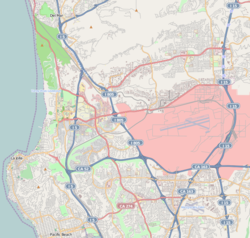
The San Francisco Museum of Modern Art (SFMOMA) is a modern and contemporary art museum and nonprofit organization located in San Francisco, California. SFMOMA was the first museum on the West Coast devoted solely to 20th-century art, and has built an internationally recognized collection with over 33,000 works of painting, sculpture, photography, architecture, design, and media arts. The collection is displayed in 170,000 square feet (16,000 m2) of exhibition space, making the museum one of the largest in the United States overall, and one of the largest in the world for modern and contemporary art.

The Los Angeles County Museum of Art (LACMA) is an art museum located on Wilshire Boulevard in the Miracle Mile vicinity of Los Angeles. LACMA is on Museum Row, adjacent to the La Brea Tar Pits.

Robert Walter Irwin was an American installation artist who explored perception and the conditional in art, often through site-specific, architectural interventions that alter the physical, sensory and temporal experience of space.
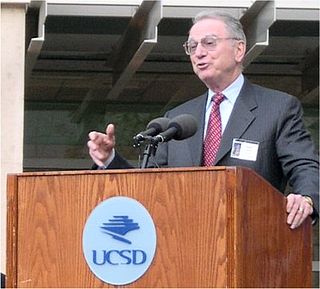
Irwin Mark Jacobs is an American electrical engineer and businessman. He is a co-founder and former chairman of Qualcomm, and chair of the board of trustees of the Salk Institute. As of 2019, Jacobs has an estimated net worth of $1.2 billion.

The Orange County Museum of Art (OCMA) is a modern and contemporary art museum located on the campus of the Segerstrom Center for the Arts in Costa Mesa, California. The museum's collection comprises more than 4,500 objects, with a concentration on the art of California and the Pacific Rim from the early 20th century to present. Exhibits include traditional paintings, sculptures, and photography, as well as new media in the form of video, digital, and installation art.
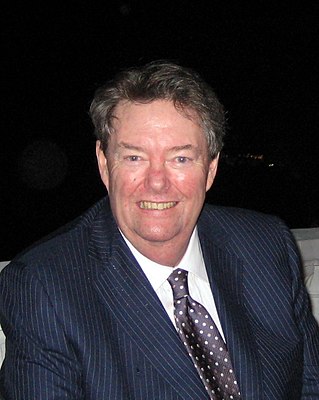
David C. Copley was an American publishing heir, on the board of the Copley Press for over thirty years, becoming president and owner, as well as publisher of the San Diego Union-Tribune. He was a noted philanthropist.
Salomón Huerta is a painter based in Los Angeles, California. Huerta was born in Tijuana, Mexico, and grew up in the Boyle Heights neighborhood of Los Angeles. Huerta received a full scholarship to attend the Art Center College of Design in Pasadena and completed his MFA at UCLA in 1998.
"America's Favorite Architecture" is a list of buildings and other structures identified as the most popular works of architecture in the United States.
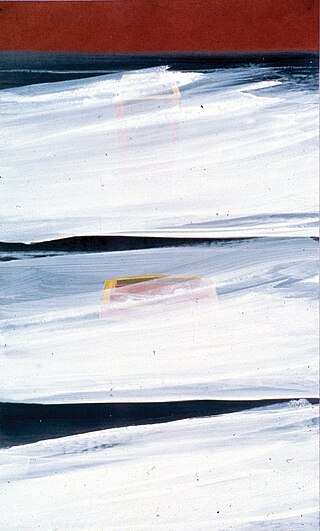
Ron Wigginton is an American artist and landscape architect. His paintings and sculptures are found in West Coast museums and many private collections. His landscapes are known for their narrative and aesthetic qualities, and his artwork typically involves and explores human perceptions of natural and built landscapes. Wigginton is considered to be one of the first Landscape Architects to approach the design of a landscape as a conceptual work of art, for which he has received international recognition through publication and awards.

Light and Space denotes a loosely affiliated art movement related to op art, minimalism and geometric abstraction originating in Southern California in the 1960s and influenced by John McLaughlin. It is characterized by a focus on perceptual phenomena, such as light, volume and scale, and the use of materials such as glass, neon, fluorescent lights, resin and cast acrylic, often forming installations conditioned by the work's surroundings. Whether by directing the flow of natural light, embedding artificial light within objects or architecture, or by playing with light through the use of transparent, translucent or reflective materials, Light and Space artists make the spectator's experience of light and other sensory phenomena under specific conditions the focus of their work. From the movement's inception, artists were incorporating into their work the latest technologies of the Southern California-based engineering and aerospace industries to develop sensuous, light-filled objects. Turrell, who has spread the movement worldwide, summed up its philosophy in saying, "We eat light, drink it in through our skins."
The La Jolla Historical Society is a private 501(c)(3) nonprofit organization in the La Jolla community of San Diego, California. According to its mission statement, it "celebrates the history and culture of this region along the water's edge through interdisciplinary programs, exhibitions, and research that challenge expectations. It balances contemporary and historic perspectives to create understanding and connection."
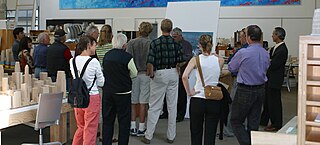
Peter Alexander was an American artist who was part of the Light and Space artistic movement in southern California in the 1960s. He is notable for his resin sculptures from the 1960s and 1970s.
RIVERA & RIVERA is a contemporary art gallery in West Hollywood, California, owned by Carlos A. Rivera.
Sarah Cain, is an American contemporary artist.

Hugo Crosthwaite is a contemporary figurative artist who is best known for his black and white graphite and charcoal drawings.

The Broad is a contemporary art museum on Grand Avenue in Downtown Los Angeles. The museum is named for philanthropists Eli and Edythe Broad, who financed the $140 million building that houses the Broad art collections. It offers free general admission to its permanent collection galleries. However, not all of its events are free and admission prices may vary by exhibit and/or by event. It opened on September 20, 2015.
Guillermo Acevedo (1920–1988) was a Peruvian-born artist and master draftsman, most famous in the United States for his striking portrayal of Native Americans of the Southwest, and for his ability to capture and help preserve the disappearing architectural styles of old neighborhoods throughout the U.S. and abroad. Known to be an artist-observer with great sensitivity, Acevedo is recognized as a master at recording the human condition.
The New Children's Museum is an arts-based children's museum in downtown San Diego, California, whose mission is to "stimulate imagination, creativity and critical thinking in children and families through inventive and engaging experiences with contemporary art". The Museum commissions contemporary artists to create room-sized art installations (playscapes) for children to interact with and explore. The Museum has collaborated with hundreds of artists since opening in 2008. The Museum is housed in a dynamic space designed by visionary and award-winning architect Rob Wellington Quigley and is one of the first green museums in California.
Elizabeth Sisco is an artist active in the Chicano art movement.

The Conrad Prebys Performing Arts Center, also known as The Conrad, is a concert hall in La Jolla, a community of San Diego, California. It was opened in April 2019 and serves as the permanent residence of the La Jolla Music Society.

